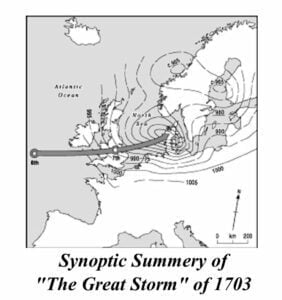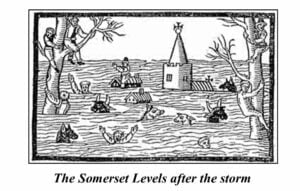
When asked this question most people say that the storm in 1953 was the worst peacetime weather disaster. It was one that claimed 307 lives in England and devastated parts of East Anglia.. However, the 1703 storm, caused by an extratropical cyclone that spread across the country and wiped out 1/3rd of our Navy!
The Great Storm of 1703.
This storm was described as an extratropical cyclone because it rushed through southern England knocking over 2000 chimneys in London alone!
In the New Forest over 4000 trees were knocked down.
However, it caused ever more damage at sea.
It blew countless ships many hundreds of miles off course and in Britain alone over 1000 seamen were blown onto the Goodwin Sands.
How it was reported.
It was a time of new technology. That new technology was The News Bulletin, which had started to be delivered all over the country.
This meant that everyone quickly knew about the disaster that had occurred. Very quickly the Church of England declared that the storm was the vengeance of gods on the sins of the country.
However, others claimed it was divine punishment for our poor performance against the Catholic armies in the war of Spanish succession. I don’t quite know which was correct, or if either was. Nevertheless, the church used it as an example to warn people of the punishment of the gods. In fact, priests used it in their sermons as a threat all the way up to the 19th century!
Did you realised fake news had been around for this long?
Would you believe that it also led the government to creating a day of fasting? They believed that it called for the deepest and most solemn humiliation of our people. The press, or should I say the broadsheets, even in those days, drove our rulers to make some odd decisions.
The Damage
It was extensive, for example in London:
- about 2000 chimney stacks were blown down.
- lead roofing was blown off Westminster Abbey.
- the monarch, Queen Anne, had to shelter in a cellar at Saint James’s palace to avoid the collapsing chimneys and roof.
- on the River Thames some 700 ships, that were at the time in the Pool of London, were pushed down the Thames into the North Sea.
Then across the country:
 In Cambridge, pinnacles were blown from the top of Kings College, Cambridge.
In Cambridge, pinnacles were blown from the top of Kings College, Cambridge.- In the West Country there was extensive flooding and particularly around Bristol.
- In the Somerset levels, hundreds of people drowned in flooding!
- The flooding also led to the death of thousands of sheep and cattle.
And, would you believe it, a ship was found 15 miles inland!
Another fascinating fact is that 400 windmills were destroyed. This is really interesting, it happened because their windmills started going around so fast that the wooden cogs got so hot they burst into flames!
The worst damage was at sea
The furthest a ship went was HMS Association. This is amazing, it was blown from Harwich all the way to Gothenburg in Sweden!
The fierce winds and high seas sank ships in the English Channel with many of them being driven onto the Goodwin sands. Now the Goodwin Sands, is vast sandbank off the South coast. It was where ships waited for favourable winds to take them up the Thames estuary to London or to take them onto the English Channel. Once the wind hit, these ships were driven onto the sands, they could not stop it, which meant over 1500 seamen were drowned that night!
The question?
We have to ask was it the worst storm in Britain? Was there a worse one? I don’t think there was.
Isn’t history fun?
10 questions to discuss:
- What is the name of the storm discussed in the passage?
- How many lives were lost in England as a result of the storm?
- What significant damage did the storm cause in London?
- What action did the government take in response to the storm?
- How did the Church of England interpret the storm’s occurrence?
- How did the storm impact maritime activities?
- What unusual event occurred regarding a ship’s journey during the storm?
- Describe some of the damage caused by the storm across different regions of England.
- What caused the destruction of windmills mentioned in the passage?
- Why was the Goodwin Sands significant during the storm, and what happened there?
For more information try:
https://www.gethistory.co.uk/historical-period/early-modern/stuart/the-great-storm-of-1703
https://www.air-worldwide.com/blog/posts/2021/12/how-great-was-storm-southern-england-1703/
https://www.squaducation.com/node/8715
©Tony Dalton



 In Cambridge, pinnacles were blown from the top of Kings College, Cambridge.
In Cambridge, pinnacles were blown from the top of Kings College, Cambridge.